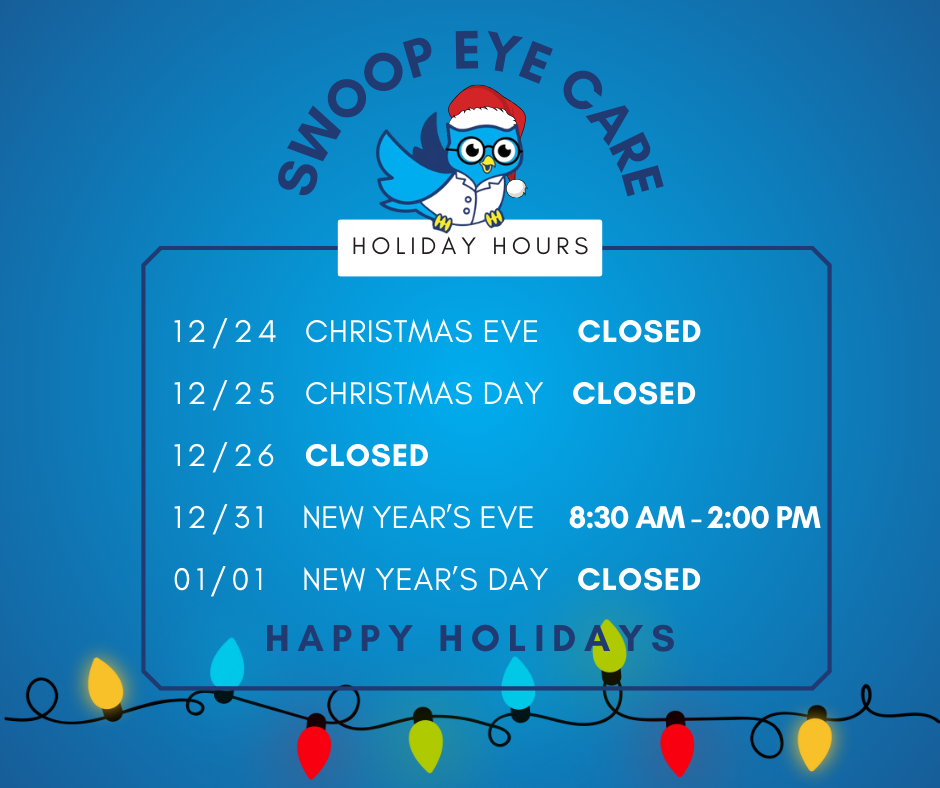Our Promise
We appreciate that you have entrusted us with the care of your patient. We will be sure to provide a detailed report sent directly to your clinic outlining the eye and vision related concerns. To begin the referral process to Swoop Eye Care, please complete send the reason for the referral/orders via fax or submit via online.
Fax – (612) 488-1564
Online Referral Referral Online
Treatment Options Available for Patients
We have provided a summary of resources to help understand products that are offered to our mutual patients. It is our goal to create an easy process for our patients.
FAQs for Prescribed Prescription Lenses
Contour Prism (Neurolens Lenses)
About: Neurolens is a specialty ophthalmic lens featuring a contour prism design. Contour Prism is like a progressive (no line bifocal) where the horizontal prism (base-in) increases when the patient looks toward the lower part of the lenses. Contour prism allows the neuro-optometrist to prescribe based on the distance prescription while having a boost of prism when looking lower. This has been shown to be particularly helpful for patients with binocular vision dysfunction. In clinical studies, the Neurolens has been shown to reduce headaches, vision motion sensitivity (movement of peripheral vision), eye fatigue, double vision, and neck pain.
Traditional Prism Lenses
About: Prism is a tool used by neuro-optometrists to shift light to a particular area in the back of the eye. By doing this, we are able to also shift the image to reduce eye strain, eliminate double vision, and improve eye comfort with both eyes open. Prism is indicated when both eyes are functional (a patient with no vision or limited vision in a particular eye typically does not benefit from prism).
FAQs by Clinicians/Therapists
Anti-Fatigue Lenses
About: A single vision lens designed to reduce eye strain, visual discomfort, and improve reading by increasing stamina and endurance. These lenses have a boost of magnification at the bottom of the lens, which has been shown to provide support for patients with binocular vision dysfunction (convergence excess, accommodative insufficiency, accommodative infacility, esophoria, and others).
Progressive Lenses
About: Progressive lenses provide relief for patients with reading problems at intermediate and reading distances. There is a no line component that provides an increase magnification when looking toward the bottom of the lenses. It is important to work with your optician, as these lenses have many designs depending on your everyday demands. Some lenses may work better than others, which is why a knowledgeable optician is recommended.
Depending on the patient's concerns, the neuro-optometrist may or may not recommend progressive lenses. Progressive lenses do have peripheral distortion when reading, as the lenses have a narrow corridor for reading. If a patient notes balance and/or dizziness, a history of falls, or has significant eye misalignment (difference between distance and near), your neuro-optometrist may not recommend progressives. This can sometimes exacerbate these problems.
Computer/Reading Lenses (Office Lenses)
About: Office lenses provide relief for patients who have significant intermediate/reading demand for their everyday needs. When the patient looks straight ahead in these lenses, the magnification is calibrated for the computer distance, with increasing magnification looking down. Traditional progressive lenses have distance vision at the top for the patient to see at distance, whereas office lenses have computer distance at the top. Conventional progressive lenses require the patient to lift the chin to be able to see well, while office lenses do not. Patients with office lenses report improvement in neck discomfort/pain, reduced visual discomfort, and reduced eye fatigue, due to the customized, ergonomically supported lens design.
Single Vision Lenses (Distance, Computer, Near)
About: Single vision lenses can be calibrated for any distance. Distance vision lenses improve distance vision (potentially near, pending the age and visual status of the patient). Computer vision lenses improve computer distance to improve clarity, decrease visual discomfort, and reduce the need to lift the chin with traditional progressive lenses. Near vision lenses improve reading distance (typically measured at 16 inches) to provide the most optimal clarity while reading a book or looking at a digital device (phone, tablet, etc.).
Shaw Lenses
About: Shaw lenses treat aniseikonia (image size differences between the two eyes) by eliminating double vision and improving debilitating vision symptoms experienced by patients. In the presence of a concussion, brain injury, a retinal condition, or other pathologic eye process, the patient experiences palinopsia (overlapping images between the eyes), eye fatigue, double vision, overstimulation of the visual environment, and other symptoms objectively measured in clinic.
Stellest Lenses (Myopia Management)
About: Stellest lenses are the first FDA-approved lenses to treat children with advancing myopia (nearsightedness). These lenses have been shown to slow the progression of myopia of up to 71% over a two-year period in clinical studies
FAQs for Therapeutic Lens Treatments
Anti-Reflective Coating
About: Anti-reflective (AR) coating is a thin layer coating put on the outer most surface of lenses to reduce reflection, which improves vision clarity, reduces eye strain, and eliminates glare from lights. This is most notable when driving at night with head lights, or computer screens. AR may also repel dust or water known as an oleophobic coating. Depending on the quality of the anti-reflective coating, this coat may be less durable or smudge more over time.
Chemistrie Clips
About: A Chemistrie Clip is where magnets are placed within the lenses to allow for multi-functional use of a single pair of glasses. The neuro-optometrist prescribed medically necessary tint (FL-41), specialty Avulux tint (only FDA treatment for migraine with light sensitivity), a polarized sunglasses clip, and/or computer distance/work lenses overlay (to be used at the computer for reading).
Photochromatic (darkening lenses)
About: Photochromatic lenses, also known as light-adaptive lenses, darken when exposed to ultraviolet (UV) light and become clear when indoors (not exposed to UV light). These lenses offer different colors, lighter/darker option when light-adaptive, turning in the car (Xtra Active) or not turning in the car (not Xtra Active), and other options. It is important to speak with your optician regarding your options and availability.
Avulux Tint
About: Avulux is brown tint proven to treat and manage patients with light sensitivity. It is FDA approved for migraines with light sensitivity. The tint selectively filters blue, amber, and red light and has undergone clinical trials tests allowing its indication for light sensitivity.
Fl-41 Tint
About: A therapeutic tint that is rose-colored to filter out blue-green spectrum of light from 480-520nm that has been scientifically studied to trigger visual discomfort/light sensitivity. There are varying densities from 10%-75%, where the higher density provides a darker tint for the patient. Typical recommendation is no greater than 50%, as it is important for patients to not rely on too dark of a lens filter.
Polarized Lenses
About: Polarized sunglasses have a special filter in the lenses that blocks directional light rays hitting the lens by improving visual clarity by reducing intense reflected light, glare. These lenses are particularly helpful while driving or enjoying outdoor activities. Reflection of light for water activities, driving in an area of snow, and many other circumstances have provided patients with relief using their polarized lenses.
FAQs for Rehabilitation Services
Neuro-Optometric Rehabilitation Therapy (Co-Management with Vision Therapist)
About: Neuro-Optometric Rehabilitation Therapy, or commonly referred to as vision therapy, is an intervention by a neuro-optometrist to provide therapeutic prescription lenses (tints, prism, contour prism, or other interventions), and binocular vision exercises to rehabilitate eye/vision dysfunctions/deficits (often referred as binocular vision dysfunctions) following a traumatic or acquired brain injury. The prescribing of lenses to manage and treat binocular vision dysfunctions is universally accepted amongst eye care professionals (optometrists, ophthalmologists); however, neuro-optometric rehabilitation therapies (vision therapy) remains controversial amongst clinicians typically not working within the rehabilitative team. For those working in the rehabilitative team, it has become the standard of care.
Important Update: Neuro-Optometric Rehabilitation (Vision Therapy) Intervention for patients with convergence insufficiency/accommodative dysfunction with early intervention provides incontrovertible evidence that support vision therapy intervention. See CONCUSS Investigator Study Results.
FAQs by Clinicians/Therapists
Occupational Therapy with Vision Exercises (Co-Management with Occupational Therapist)
About: Occupational therapy (OT) helps individuals with injuries, illnesses, or disabilities perform daily tasks to improve overall well-being. There are occupational therapists that are trained to complete vision related eye exercises focusing on patients with binocular vision dysfunction.
Occupational Therapy in Low Vision (Co-Management with Occupational Therapist)
About: Occupational therapy (OT) helps individuals with injuries, illnesses, or disabilities perform daily tasks to improve overall well-being. There are occupational therapists that are trained to complete low vision related activities to improve the quality of life for patients living with advanced loss of central and/or peripheral vision from a stroke, brain tumor, traumatic brain injuries, and eye related diseases (glaucoma, macular degeneration). The occupational therapist may provide magnification tools, devices to improve function, and many other resources to help with tasks often taken for granted prior to the loss of vision.
Occupational Therapy for Driving Assessment
About: Occupational therapy driving assessment evaluates a patient's physical, visual, and cognitive abilities to determine his or her fitness to drive. These assessments may include clinical and behind-the-wheel evaluation from a certified therapist/clinic location. The assessments identify strengths and weaknesses that can lead to recommendations for adaptive equipment, driver training, and/or other community mobility options promoting safe and independent driving (if appropriate).
Physical Therapy for Vestibular Dysfunction (Management with Physical Therapist)
About: A vestibular physical therapist evaluates vestibular function, sometimes referred to as a balance assessment, to identify peripheral system dysfunctions where the inner ear and brain are not appropriately functioning well together. Patients often experience, intermittent double vision, vertigo, dizziness, balance problems, falls, spinning sensations, nausea, vomiting, and a host of other signs/symptoms.
If treatment is required, the vestibular physical therapist may provide treatment via different head positions to appropriately move the inner ear crystals into their appropriate place (known as canalith repositioning). In addition, the physical therapist may provide other exercises and maneuvers to improve gaze stabilization, balance and postural control, neck and postural management, habituation exercises, and many other personalized treatments pending your unique diagnosis or diagnoses.
Chiropractic Rehabilitative Care (Functional Neurology via Chiropractic Care)
About: A chiropractor trained in the principles of functional neurology focus on assessing and rehabilitating the nervous system through non-invasive, drug-free methods. Depending on the tools available to your provider, you may have an assessment in vestibular care, chiropractic manipulation, neurofeedback, visual-motor training, cognitive and physical therapy, and nutritional interventions.












